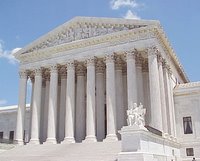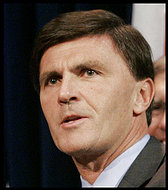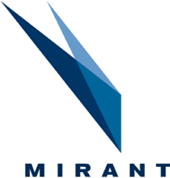Washington, DC
30 June 2006
Dear Friends and Colleagues:
Some of you undoubtedly saw Michiko Kakutani’s virulent review of
Dark Ages America in the June 16, 2006, issue of the
New York Times. For those of you who have read DAA, you know her review was not merely a distortion of the book, but rather an outright lie–a fabricated version of what the book is about. Ms. Kakutani has a reputation for this sort of poison-pen-style demolition of serious authors, but I couldn’t help thinking that the great American tradition of red-baiting was at work here as well, as the references to Anne Coulter and Bill O’Reilly at the end of her review would suggest. In other words, she serves the
Times’ purposes well: by savaging a left-wing study (and just to set the record straight, DAA has many things in it that conservatives would agree with), the
Times can protect its flanks not only from the likes of Coulter and O’Reilly, but also from the Bush administration as well: "See? We attack the left; we’re not liberals at all! We’re ‘objective’."
Personally, I can’t help feeling that the NYT has fallen a great distance from the golden days of the Sulzberger family, and the once-admirable slogan of "All The News That’s Fit To Print." Beyond the embarrassing Jayson Blair affair, there is the matter of the newspaper fanning the flames for the 2003 invasion of Iraq by repeatedly publishing, on the front page, dubious unchecked stories regarding Iraq’s alleged WMD; and then, a year later (26 May 2004), admitting what it had done in a belated lukewarm apology to its readers–tucked away on p. 10 (on this see DAA, pp. 211 and 220). One has to wonder what in the world right-wing radio hosts are thinking when they rant against the
Times as part of "the liberal media."
My own frustration, of course, is that of being smeared–for that is what Kakutani’s review amounted to–and then not being allowed the opportunity for a rebuttal. It is the NYT’s practice to phone writers of letters submitted to verify the authenticity of authorship. As it is now two weeks since I sent them an e-mail reply (below) to the review of my book, and I have received no such phone call, it would seem to be the case that the
Times is content to "hit and run," so to speak. So the Kakutani version of the book becomes the "official" version in absence of a printed objection to it; it gets reprinted in the
International Herald Tribune, which is sold in nearly every major city in the world, and is also translated into a number of foreign languages and reprinted in foreign newspapers. We do not, in this country, have the sort of censorship that obtained in the former USSR; rather, ours is much more subtle, and in the long run, probably much more effective. Bottom line: truly alternative voices cannot get heard here, and that is, to me, the saddest aspect of this whole thing.
Let me stop at that point. Hopefully, my letter of June 16 speaks for itself. In lieu of getting it published, I am posting it on my website (
www.morrisberman.com) and ask that you send this message to anyone who you think may be interested in it. As follows:
To the Editor:
I am writing this in response to Michiko Kakutani’s savage review (16 June 2006) of my book
Dark Ages America. The irony about her accusation that the book is a "rant" and that it contains no "carefully reasoned analysis" is that this description applies precisely to her review, rather than to my book. Ms. Kakutani never engages the text at the level of content; she never really tells the reader what is in the book, and therefore is spared the difficulty of critiquing it point by point. Indeed, she fails to contradict a single conclusion of the book with a fact or an argument. Chapter by chapter, in a carefully reasoned and heavily footnoted way,
Dark Ages America discusses the repeal of the Bretton Woods Accords in 1971, and the consequent rise of finance capital; the development of the containment policy in the years following George Kennan’s formulation of it, and its subsequent impact on our foreign policy; the CIA-engineered overthrow of legitimate regimes (ably documented, for example, by
New York Times reporter Stephen Kinzer), and the sewing of bitter resentment toward the United States in the Islamic world; Jimmy Carter’s unsuccessful attempt to address some of these entrenched patterns; the twentieth-century creation of a suburban landscape, and its role in American culture and politics; the economic challenge now being posed to us by China and the European Union–etc. None of this is addressed in a review that is little more than a disturbed emotional outburst, completely over the top. What recourse do I have in the face of such an utterly dishonest diatribe, except to urge the reader to check the text out for him- or herself?
My distress over this, however, goes beyond the personal to the sadness I feel for the country as a whole. What chance does the United States have if a carefully reasoned, empirically substantiated diagnostic look at how we got here gets completely blown out of the water by the nation’s premier representative of the Fourth Estate? A leading American historian wrote me, after reading
Dark Ages America: "You have done this country a great service"; and a major German newspaper reviewed the book under the title, "Hopes of a Patriot." America’s major institutions, on the other hand, seem to be increasingly incapable of recognizing that incisive critics are the best friends this country has. By refusing to engage in actual dialogue over the issues raised in the book, and responding instead with a smear, the
Times review is actually hastening the Dark Ages I describe in the text. The "sorrows of empire," as Chalmers Johnson puts it, are indeed upon us.
Sincerely,
Morris Berman
Washington, DC
16 June 2006
 The U.S. House of Representatives approved legislation (H.R. 4761) on June 29, 2006 sponsored by Congressman Bobby Jindal that lifts a 25-year ban on oil and natural gas drilling off most of the Pacific and Atlantic coasts and the eastern part of the Gulf of Mexico. The legislation passed by a vote of 232-187 and offers states billions of dollars in federal revenues if they allow drilling off their coasts.
The U.S. House of Representatives approved legislation (H.R. 4761) on June 29, 2006 sponsored by Congressman Bobby Jindal that lifts a 25-year ban on oil and natural gas drilling off most of the Pacific and Atlantic coasts and the eastern part of the Gulf of Mexico. The legislation passed by a vote of 232-187 and offers states billions of dollars in federal revenues if they allow drilling off their coasts.






 Black Enterprise
Black Enterprise































